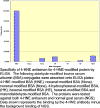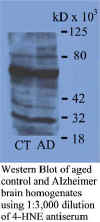The peroxidation of
membrane lipids by free radicals is a well-controlled, ongoing process
that occurs during normal cell turnover and the normal aging process.
There is also the uncontrolled process of free radical production
and increased lipid peroxidation that is associated with hepatic injury
as a consequence of exposure to halogenated hydrocarbons, excessive
alcohol abuse, and acute or chronic iron overload.
Excess free radical production and lipid peroxidation is thought
to be an etiological factor in such diseases as atherosclerosis,
diabetes, genetic hemochromatosis, cancer and neurodegenerative
diseases, such as Alzheimer’s and Parkinson’s disease.
4-Hydroxynonenal (HNE)
is a highly reactive, cytotoxic aldehyde that is released during the
oxidation of w-6-unsaturated
fatty acids. HNE can efficiently react with sulfhydryl groups or histidine
and lysine groups of proteins to form stable HNE-protein adducts, in
addition to phospholipids and nucleic acids.
It is through this HNE-modification of biomolecules that HNE is
thought to exert its cytotoxic effects.
This multifunctional molecule may be considered as a “second
toxic messenger,” which disseminates and augments initial free radical
events. It is believed to
be largely responsible for the cytopathological effects observed during
oxidative stress. High
levels of 4-HNE have been detected in a large number of disease states,
indicating some involvement of this aldehyde in their pathogenesis.
Some of the prominent pathobiochemical effects of 4-HNE are its
stimulation of fibrogenesis and inflammation. This indicates a
potential contribution to the pathogenesis of several chronic diseases,
the progression of which is supported by inflammatory reactions and characterized by fibrosis. 4-HNE
may also play a role in carcinogenesis due to its ability to modulate
cell proliferation through interference with the activity of cyclins and
protein kinases and inhibiting the apoptotic response.
characterized by fibrosis. 4-HNE
may also play a role in carcinogenesis due to its ability to modulate
cell proliferation through interference with the activity of cyclins and
protein kinases and inhibiting the apoptotic response.
A goat antiserum to
4-HNE is currently available. This antiserum has been shown to be
immunoreactive with 4-HNE-modified bovine serum albumin (BSA) by ELISA.
Additionally, this antibody has been shown by ELISA to have minimum
cross-reactivity with other aldehyde-BSA conjugates, making it highly specific for 4-HNE.
Western blot analysis demonstrtes that the antiserum is capable of detecting proteins modified by HNE-adducts. This product should be a valuable tool for scientists working to
understand the role of 4-HNE in the pathogenesis of various diseases.
detecting proteins modified by HNE-adducts. This product should be a valuable tool for scientists working to
understand the role of 4-HNE in the pathogenesis of various diseases.
4-HNE-modified
BSA (Cat no. HMP044H), which can be used as a positive control or to
neutralize immunoreactivity, is also available.
Manufacturing
Reference:
Boon,
P.J.M., et al. Tox. Appl. Pharmacol. 159:214-223, 1999.